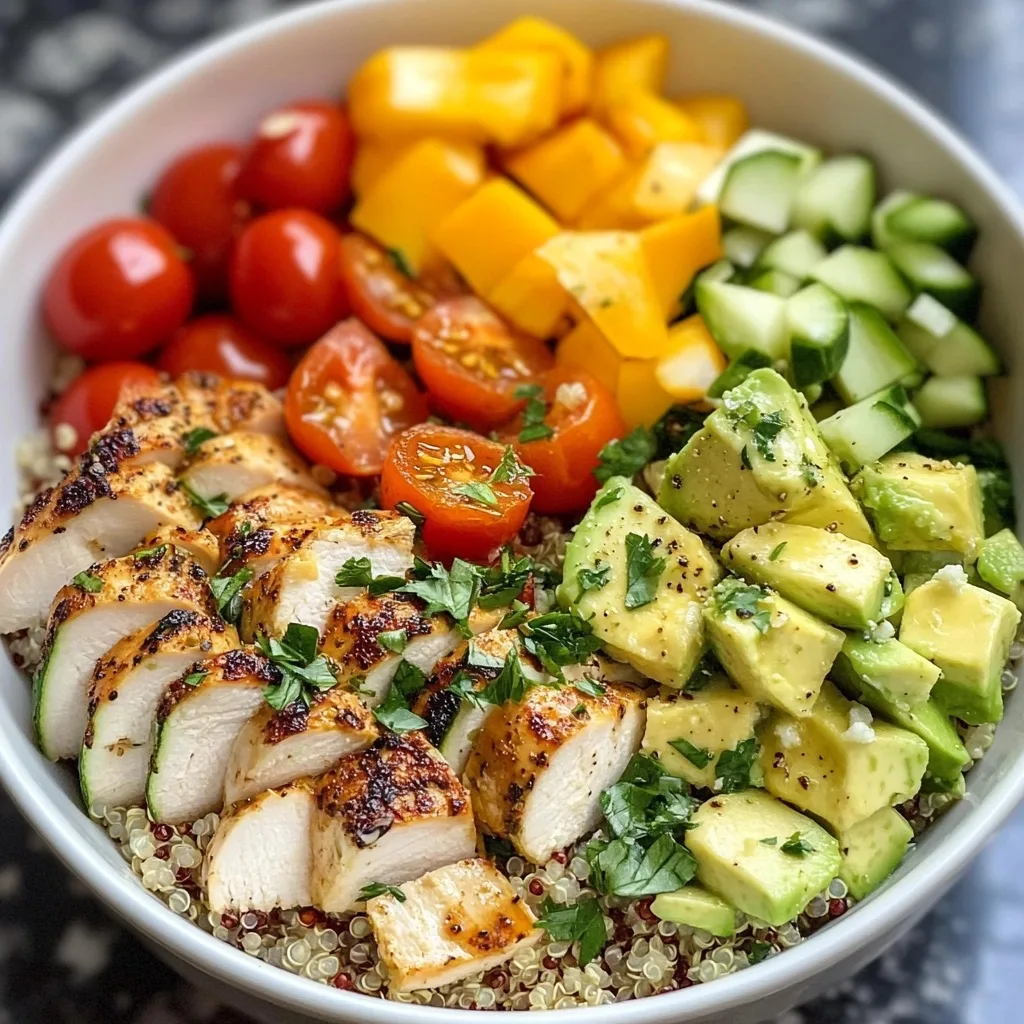Living with gestational diabetes requires thoughtful meal planning that balances nutrition with blood sugar management. The Gestational Diabetes Quinoa Bowl offers a perfect solution – combining complex carbohydrates, lean proteins, and abundant vegetables to create a satisfying meal that helps maintain stable glucose levels. This versatile, nutrient-dense recipe is designed specifically with gestational diabetes in mind, but it’s delicious enough for the whole family to enjoy.
What sets the Gestational Diabetes Quinoa Bowl apart is its careful balance of ingredients that work together to provide sustained energy without causing problematic blood sugar spikes. The protein-rich quinoa serves as an excellent alternative to refined carbohydrates, while the colorful array of vegetables adds essential vitamins, minerals, and fiber. With customizable protein options and a creamy avocado drizzle that’s both indulgent and nutritious, this bowl proves that managing gestational diabetes doesn’t mean sacrificing flavor or satisfaction.
Understanding Gestational Diabetes and Dietary Needs
Gestational diabetes affects approximately 2-10% of pregnancies annually in the United States. This condition, which develops during pregnancy, requires careful attention to diet to maintain healthy blood glucose levels for both mother and baby. Unlike type 1 or type 2 diabetes, gestational diabetes typically resolves after delivery, but proper management during pregnancy is crucial.
When planning meals for gestational diabetes, the focus should be on balancing macronutrients – particularly limiting simple carbohydrates that can cause rapid blood sugar spikes. The ideal meal combines complex carbohydrates, lean proteins, healthy fats, and fiber-rich vegetables. This combination helps slow the absorption of glucose into the bloodstream, preventing the dramatic rises and falls in blood sugar that can be problematic during pregnancy.
The Gestational Diabetes Quinoa Bowl is specifically designed with these nutritional principles in mind. Quinoa provides complex carbohydrates with a lower glycemic index than many grains, meaning it won’t cause rapid spikes in blood sugar. Combined with lean protein from chicken or salmon and abundant fiber from various vegetables, this dish creates the perfect nutritional profile for gestational diabetes management.
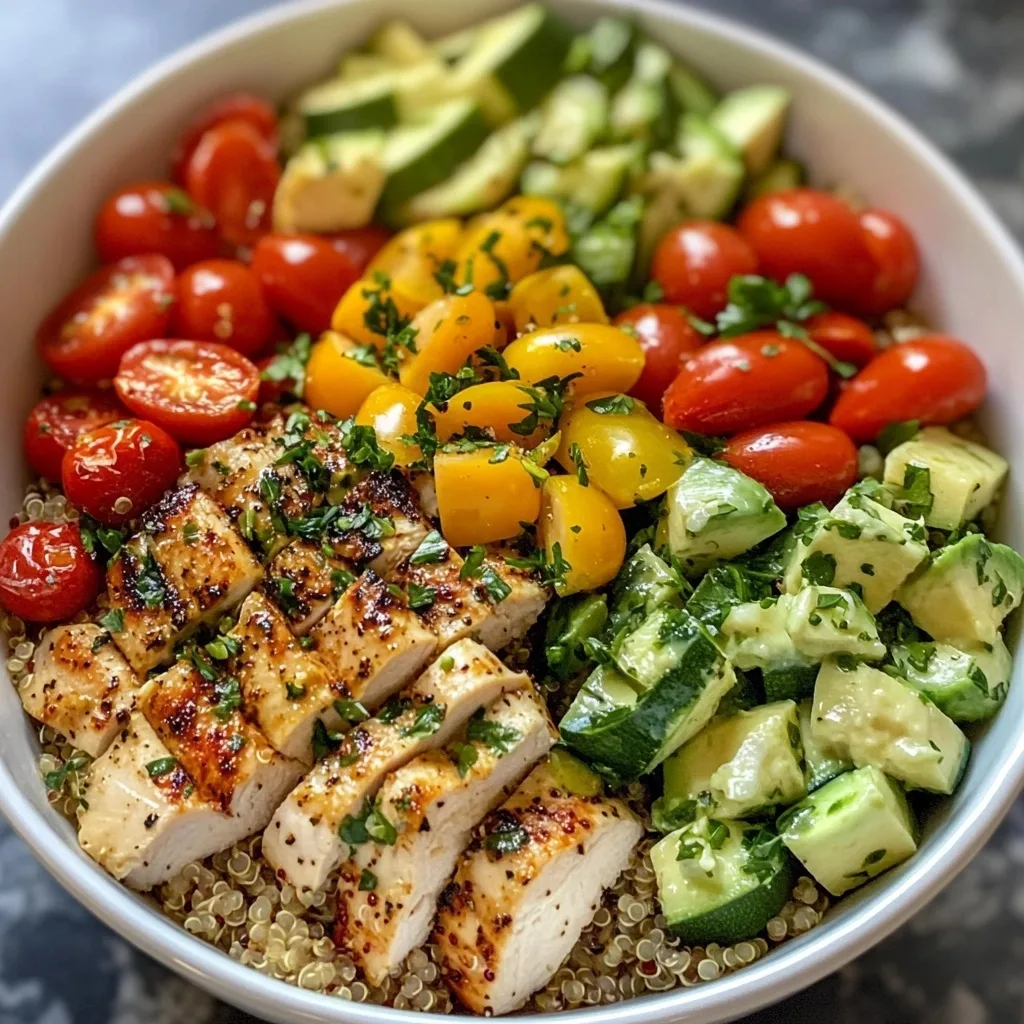
Nutritional Benefits of the Gestational Diabetes Quinoa Bowl
Quinoa: The Perfect Complex Carbohydrate Base
Quinoa stands out as an exceptional foundation for the Gestational Diabetes Quinoa Bowl. Unlike refined grains, quinoa is a complex carbohydrate with a relatively low glycemic index of around 53, making it a smart choice for blood sugar management. Additionally, quinoa is one of the few plant foods that contains all nine essential amino acids, qualifying it as a complete protein source – a rare quality in the plant kingdom.
Just one cup of cooked quinoa provides approximately 8 grams of protein and 5 grams of fiber, both of which help slow the digestion and absorption of carbohydrates, preventing rapid blood sugar spikes. The fiber content also promotes satiety, helping you feel fuller longer and potentially reducing overall calorie intake.
Quinoa is rich in magnesium, a mineral that plays a role in glucose metabolism and insulin sensitivity. Research suggests adequate magnesium intake may improve glucose control, making it particularly beneficial for those managing gestational diabetes. Additionally, quinoa provides manganese, phosphorus, folate, and B vitamins – all important nutrients during pregnancy.
Vegetable Variety for Essential Nutrients
The colorful array of vegetables in the Gestational Diabetes Quinoa Bowl isn’t just visually appealing – it’s nutritionally strategic. Each vegetable brings unique benefits to support maternal and fetal health while helping manage blood sugar levels.
Zucchini, with its high water content and low carbohydrate profile, adds bulk and nutrition without significantly impacting blood glucose. Bell peppers provide vitamin C, which supports immune function and iron absorption – particularly important during pregnancy when iron needs increase. The cherry tomatoes contain lycopene, an antioxidant that may help reduce inflammation, while spinach contributes iron, calcium, and folate – critical for preventing neural tube defects.
Collectively, these vegetables add substantial fiber, which slows carbohydrate absorption and promotes healthy digestion. The fiber, water content, and volume of vegetables allow for a satisfying portion size with minimal impact on blood sugar – a winning combination for gestational diabetes management.
Protein Options for Sustained Energy
Protein plays a crucial role in blood sugar management by slowing digestion and providing satiety without impacting glucose levels. The Gestational Diabetes Quinoa Bowl offers flexibility with two excellent protein options: rotisserie chicken or baked salmon.
Rotisserie chicken provides lean protein that’s convenient and family-friendly. A 3-ounce serving contains approximately a25 grams of high-quality protein with minimal carbohydrates. Chicken also supplies B vitamins and minerals like selenium and phosphorus.
The salmon alternative offers similar protein benefits with the added advantage of omega-3 fatty acids. These essential fats are critically important during pregnancy for fetal brain and eye development. Research suggests omega-3s may also have anti-inflammatory properties that could potentially benefit insulin sensitivity, making salmon an especially smart choice for gestational diabetes.
Healthy Fats for Balance and Satisfaction
The Gestational Diabetes Quinoa Bowl incorporates healthy fats through olive oil, optional feta cheese, and the avocado drizzle. These fats serve multiple purposes in a gestational diabetes-friendly meal.
First, fats slow gastric emptying, which means glucose enters the bloodstream more gradually, preventing rapid blood sugar spikes. Second, healthy fats increase satisfaction and palatability, making the meal more enjoyable and potentially reducing cravings for less blood sugar-friendly foods later.
The optional avocado drizzle deserves special mention. Avocados contain monounsaturated fats that may improve insulin sensitivity. They’re also rich in potassium, fiber, and folate – all beneficial during pregnancy. When combined with Greek yogurt, the drizzle adds additional protein and calcium, creating a creamy, satisfying topping without excessive carbohydrates.
Preparing Your Gestational Diabetes Quinoa Bowl
Gathering Ingredients and Equipment
Before beginning preparation of your Gestational Diabetes Quinoa Bowl, gather all ingredients and necessary equipment. For this recipe serving four people, you’ll need:
For the bowl:
- 1½ cups rinsed quinoa
- 3 cups low-sodium chicken or vegetable broth
- 1 tablespoon extra-virgin olive oil
- 1 small yellow onion, finely diced
- 2 cloves garlic, minced
- 1 medium zucchini, diced
- 1 cup cherry tomatoes, halved
- 1 red bell pepper, diced
- 1 cup baby spinach, roughly chopped
- 1 cup cooked, shredded rotisserie chicken (or baked salmon)
- ½ cup crumbled feta cheese (optional)
- ¼ cup chopped fresh parsley
- Juice of 1 lemon
- Salt & freshly cracked black pepper, to taste
- A pinch of red pepper flakes (optional)
For the avocado drizzle:
- 1 ripe avocado
- 2 tablespoons plain Greek yogurt
- 1 tablespoon fresh lime juice
- 2 tablespoons water
- Salt & pepper, to taste
Equipment needed:
- Medium saucepan with lid
- Large skillet
- Cutting board and knife
- Measuring cups and spoons
- Wooden spoon or spatula
- Small food processor or fork for avocado drizzle
- Serving bowls
Having everything measured and prepared before cooking (mise en place) makes the cooking process much smoother, especially when managing multiple components simultaneously.
Cooking the Quinoa Perfectly
Properly cooked quinoa forms the foundation of your Gestational Diabetes Quinoa Bowl. Follow these steps for fluffy, perfectly cooked quinoa:
- Rinse 1½ cups quinoa thoroughly under cold water using a fine-mesh strainer. This removes the natural saponin coating that can impart bitterness.
- In a medium saucepan, bring 3 cups of low-sodium broth to a gentle simmer. Using broth instead of water adds flavor without the need for additional salt.
- Add the rinsed quinoa to the simmering broth and stir once.
- Cover the saucepan and reduce heat to low, maintaining a very gentle simmer.
- Cook undisturbed for 15-18 minutes, until the liquid is absorbed and the quinoa’s characteristic spiral germ becomes visible.
- Remove from heat but keep covered for an additional 5 minutes to allow the quinoa to steam and fully absorb any remaining moisture.
- Fluff gently with a fork to separate the grains before incorporating with other ingredients.
Using broth instead of water not only enhances the flavor but also adds valuable nutrients. Choose low-sodium versions if you’re monitoring sodium intake during pregnancy.
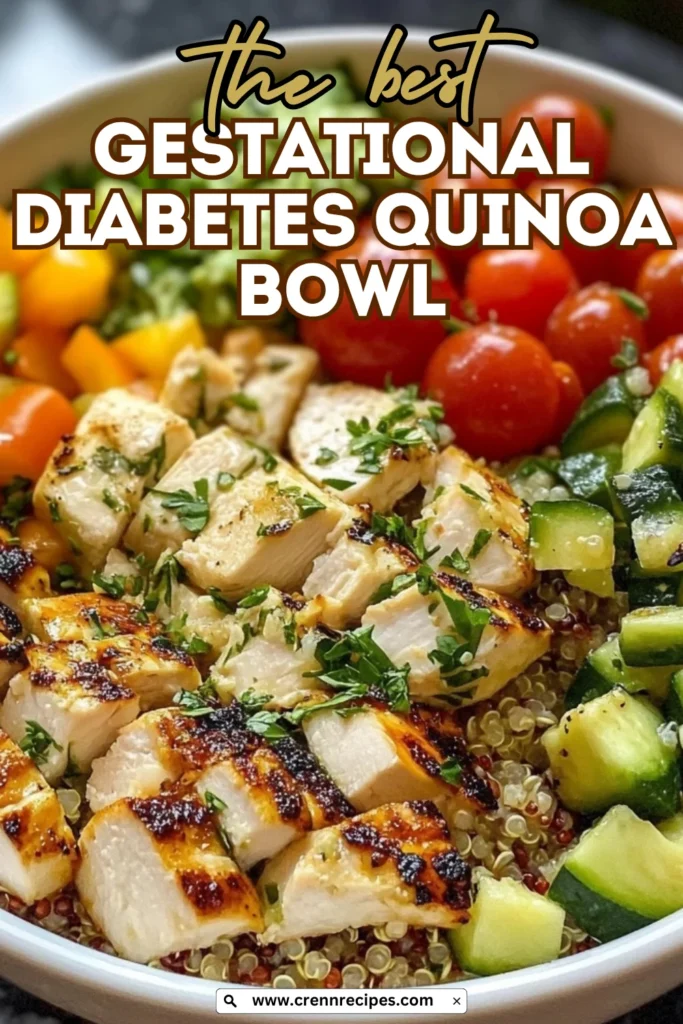
Sautéing Vegetables for Maximum Flavor and Nutrition
While the quinoa cooks, prepare the vegetable mixture:
- Heat 1 tablespoon olive oil in a large skillet over medium heat.
- Add diced onion and cook for about 2 minutes until it begins to soften.
- Add minced garlic and cook for another 30 seconds until fragrant, being careful not to burn it.
- Add the diced zucchini and red bell pepper to the skillet. Sauté for 4-5 minutes until they begin to soften but still maintain some crispness. This preserves their nutrients and texture.
- Stir in halved cherry tomatoes and cook for 1-2 minutes until they just begin to release their juices.
- Finally, add the chopped spinach and stir until wilted, which should take only about 1 minute.
The key to perfectly cooked vegetables is to add them to the skillet in order of their cooking times, with firmer vegetables going in first. This ensures that each vegetable reaches ideal doneness without some becoming overcooked and others remaining too raw.
Combining and Seasoning the Bowl
Once the quinoa and vegetables are cooked, it’s time to bring everything together:
- Add the cooked quinoa to the skillet with the vegetable mixture.
- Gently fold in the shredded rotisserie chicken (or flaked salmon if using that option).
- Drizzle with fresh lemon juice, which brightens the flavors and adds a refreshing acidity.
- Sprinkle with chopped fresh parsley, salt, pepper, and optional red pepper flakes.
- Gently toss all ingredients together to ensure even distribution of flavors and textures.
The goal is to have a balanced bowl where each bite contains a little of everything, creating a satisfying and nutritionally complete meal.
Creating the Optional Avocado Drizzle
The creamy avocado drizzle adds healthy fats and incredible flavor without significantly impacting blood glucose levels:
- In a small food processor, combine the flesh of one ripe avocado, 2 tablespoons of Greek yogurt, and 1 tablespoon of fresh lime juice.
- Process until smooth, adding up to 2 tablespoons of water as needed to achieve a drizzling consistency.
- Season with salt and pepper to taste.
- If you don’t have a food processor, mash the ingredients together with a fork until as smooth as possible.
This optional topping adds creaminess and healthy fats that further slow carbohydrate absorption, making it both delicious and beneficial for blood sugar management.
Portion Control and Meal Timing for Gestational Diabetes
Understanding Portion Sizes
Portion control is crucial when managing gestational diabetes. The Gestational Diabetes Quinoa Bowl recipe yields four servings, with each portion providing a balanced meal that’s substantial enough to satisfy hunger without overwhelming blood glucose levels.
A proper portion should include approximately:
- ¾ cup cooked quinoa
- 1 to 1½ cups of the vegetable mixture
- 3-4 ounces of protein (chicken or salmon)
- 1-2 tablespoons of feta cheese (if using)
- 1-2 tablespoons of avocado drizzle (if using)
This combination delivers approximately 350-400 calories with a balanced macronutrient profile of complex carbohydrates, lean protein, and healthy fats. Most importantly, the carbohydrates are spread throughout the meal, paired with protein, fat, and fiber, minimizing their impact on blood sugar.
When serving, use a measuring cup the first few times to develop an eye for appropriate portions. This helps ensure you’re neither under-eating (which could lead to excessive hunger later) nor over-consuming carbohydrates.
Optimal Meal Timing
For those managing gestational diabetes, when you eat is almost as important as what you eat. Consider these timing strategies when incorporating the Gestational Diabetes Quinoa Bowl into your meal plan:
- Evenly spaced meals: Aim to eat this bowl as part of a routine of 3 moderate meals and 2-3 small snacks evenly distributed throughout the day. This approach helps prevent both hunger and blood sugar fluctuations.
- Protein-first approach: Begin eating the protein-rich portions of the bowl first, as protein has minimal impact on blood glucose while helping to slow the absorption of carbohydrates consumed afterward.
- Post-meal activity: Consider taking a gentle 10-15 minute walk after enjoying your Gestational Diabetes Quinoa Bowl. Light activity after meals can help your body process glucose more efficiently.
- Blood glucose monitoring: If you’re tracking blood glucose, measure levels before and 1-2 hours after eating this meal to understand how it affects your individual response. This information can help you make personalized adjustments.
Remember that individual responses to foods vary, even among those with gestational diabetes. Work with your healthcare provider to develop timing strategies tailored to your specific needs and glucose patterns.
Customizing Your Gestational Diabetes Quinoa Bowl
Adapting to Personal Taste Preferences
One of the greatest strengths of the Gestational Diabetes Quinoa Bowl is its adaptability. You can customize it to suit your personal preferences while still maintaining its blood sugar-friendly profile:
- Vegetable substitutions: Don’t care for zucchini? Swap it for yellow squash, cucumber, or sugar snap peas. The key is maintaining a similar volume of non-starchy vegetables.
- Herb variations: Replace parsley with cilantro, basil, or dill depending on what flavor profile you prefer.
- Spice adjustments: For those who enjoy heat, increase the red pepper flakes or add a sprinkle of cayenne. If you prefer milder flavors, omit the red pepper entirely.
- Acid alternatives: The recipe calls for lemon juice, but lime or a splash of red wine vinegar could work equally well, depending on your preference.
The beauty of bowl-style recipes is that each component can be adjusted independently, allowing for remarkable versatility while maintaining the nutritional balance necessary for gestational diabetes management.
Seasonal Adaptations
Another advantage of the Gestational Diabetes Quinoa Bowl is its adaptability to seasonal produce, which typically offers better flavor, higher nutrient content, and often lower cost:
- Spring variations: Incorporate asparagus, peas, and tender young spinach with herbs like dill and mint.
- Summer options: Feature summer squash, sweet bell peppers, cherry tomatoes, and fresh basil.
- Fall adaptations: Include roasted butternut squash, Brussels sprouts, and sage for a heartier autumn version.
- Winter alternatives: Incorporate roasted root vegetables like carrots and turnips with hearty greens like kale.
By adapting your bowl to seasonal produce, you’ll naturally introduce variety into your meal plan, preventing boredom while maintaining blood sugar-friendly nutrition.
Making It a Family Meal
While designed for gestational diabetes management, this quinoa bowl can easily become a family favorite with simple modifications:
- For children: Separate components for picky eaters, allowing them to build their own bowls. This encourages autonomy while ensuring they get a balanced meal.
- For partners or family members with higher caloric needs: Offer additional quinoa, protein, or healthy fat options like nuts or additional avocado.
- For those who need additional carbohydrates: Serve with a small portion of whole grain bread or fruit for family members who aren’t managing blood sugar concerns.
With minimal adaptation, one meal can serve diverse nutritional needs, saving time and ensuring everyone enjoys a nutritious dinner together.
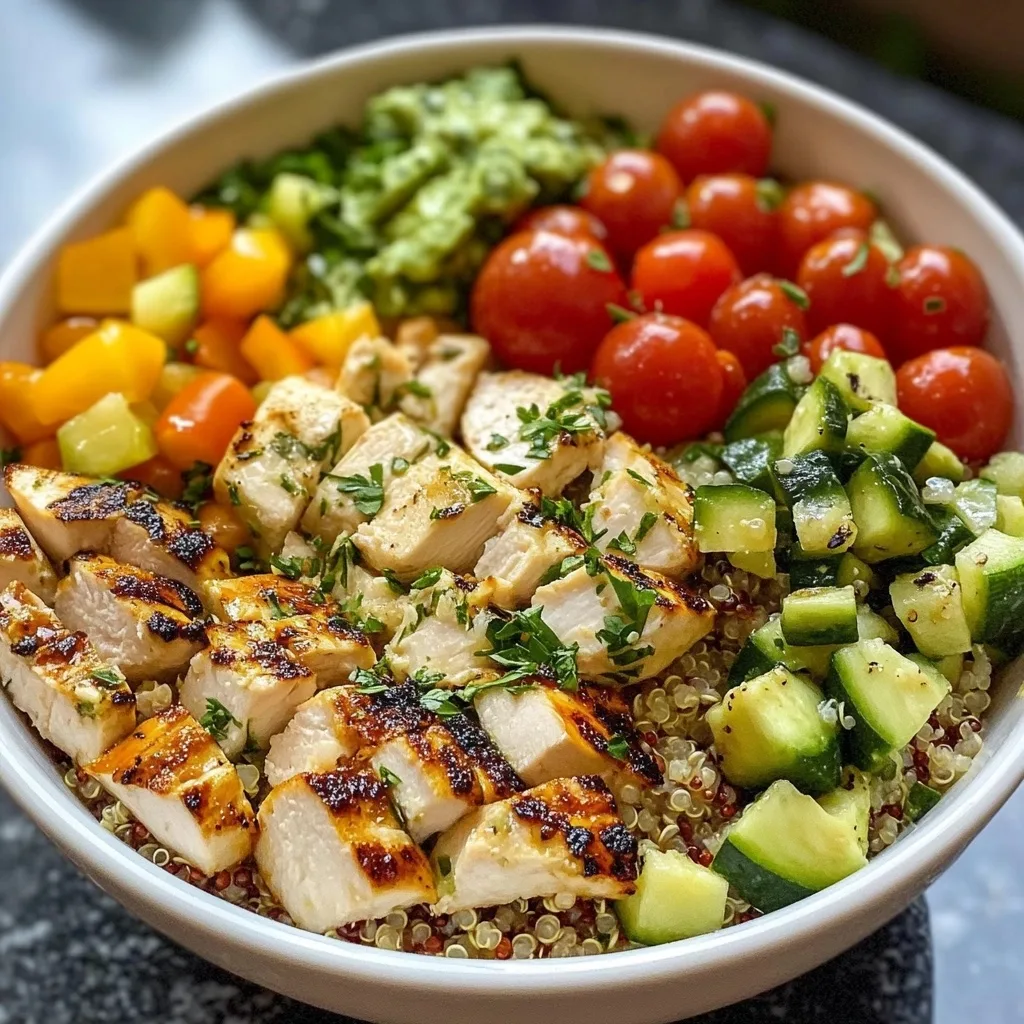
Meal Prep and Storage Tips
Preparing Components in Advance
The Gestational Diabetes Quinoa Bowl is ideal for meal preparation, which can be particularly helpful when managing pregnancy fatigue along with diabetes:
- Cook quinoa in batches: Prepare a double batch of quinoa and refrigerate for up to 4 days or freeze in portion-sized containers for up to 3 months.
- Chop vegetables ahead: Prepare all vegetables (except spinach) up to 3 days in advance and store in airtight containers in the refrigerator.
- Pre-cook protein: Shred rotisserie chicken or prepare baked salmon and portion into containers for quick assembly during the week.
- Make extra avocado drizzle: The avocado drizzle can be prepared a day in advance with a thin layer of lime juice on top and stored in an airtight container to prevent browning.
With these components ready, you can assemble a fresh bowl in under 10 minutes, making it practical even on busy weeknights.
Storage Recommendations
Proper storage ensures food safety and maintains the quality of your prepared components:
- Cooked quinoa: Store in an airtight container in the refrigerator for up to 4 days. When reheating, add a tablespoon of water to restore moisture.
- Prepared vegetables: Store raw, cut vegetables in containers lined with paper towels to absorb excess moisture and extend freshness.
- Cooked bowls: If storing fully assembled bowls, keep the avocado drizzle separate until serving. Assembled bowls without the drizzle can be refrigerated for up to 3 days.
- Freezing options: While the complete assembled bowls don’t freeze well due to the fresh vegetables, you can freeze cooked quinoa and cooked protein separately in freezer-safe containers for future use.
Proper food safety is particularly important during pregnancy, so always refrigerate prepared foods promptly and use refrigerated leftovers within 4 days.
Blood Sugar Monitoring and Gestational Diabetes Quinoa Bowl
Understanding Your Body’s Response
While the Gestational Diabetes Quinoa Bowl is designed to be blood sugar-friendly, individual responses can vary. Monitoring your glucose after eating this meal can provide valuable insights:
- Test your blood sugar before eating the Gestational Diabetes Quinoa Bowl to establish a baseline.
- Enjoy your portion of the meal, noting the time you finish eating.
- Test your blood sugar again 1-2 hours after the meal, according to your healthcare provider’s recommendations.
- Record both readings along with notes about the specific portion sizes and any modifications you made to the recipe.
This data helps you understand how your body specifically responds to this meal, allowing for personalized adjustments as needed.
Adjusting Based on Monitoring Results
If you find that the Gestational Diabetes Quinoa Bowl causes blood sugar changes outside your target range, consider these adjustments:
- If blood sugar rises too high: Slightly reduce the quinoa portion and increase the protein and non-starchy vegetables. Consider adding more healthy fats through additional avocado or olive oil, which can help slow carbohydrate absorption.
- If blood sugar drops too low: You may need to increase the portion size slightly or add a small piece of fruit or whole grain bread to provide additional carbohydrates.
- If timing seems to matter: Pay attention to when during the day you eat this meal. Some women with gestational diabetes find that their bodies handle carbohydrates better at certain times of day.
Always discuss significant changes with your healthcare team, as they can provide personalized guidance based on your specific needs and glucose patterns.
The Complete Gestational Diabetes Quinoa Bowl Recipe
Here’s the complete recipe for the Gestational Diabetes Quinoa Bowl, serving four:
Ingredients:
For the bowl:
- 1½ cups rinsed quinoa
- 3 cups low-sodium chicken or vegetable broth
- 1 tablespoon extra-virgin olive oil
- 1 small yellow onion, finely diced
- 2 cloves garlic, minced
- 1 medium zucchini, diced
- 1 cup cherry tomatoes, halved
- 1 red bell pepper, diced
- 1 cup baby spinach, roughly chopped
- 1 cup cooked, shredded rotisserie chicken (or baked salmon for a pescatarian twist)
- ½ cup crumbled feta cheese (optional)
- ¼ cup chopped fresh parsley
- Juice of 1 lemon
- Salt & freshly cracked black pepper, to taste
- A pinch of red pepper flakes (optional)
For the Creamy Avocado Drizzle (optional):
- 1 ripe avocado
- 2 tablespoons plain Greek yogurt
- 1 tablespoon fresh lime juice
- 2 tablespoons water (to thin)
- Salt & pepper, to taste
Instructions:
Cook that quinoa
- In a medium saucepan, bring broth to a gentle simmer.
- Stir in quinoa, cover, and reduce heat to low.
- Let it steam for 15–18 minutes, until all the liquid’s absorbed and the grains fluff up.
- Remove from heat, fluff with a fork, and set aside.
Sauté the veggies
- While your quinoa cooks, heat olive oil in a large skillet over medium heat.
- Toss in the onion and garlic—cook until fragrant and translucent, about 2–3 minutes.
- Add zucchini and bell pepper; sauté until tender-crisp, about 4–5 minutes more.
- Stir in cherry tomatoes and spinach, cooking just until the greens wilt.
Combine & season
- Fold the cooked quinoa and shredded chicken into the veggie mixture.
- Drizzle lemon juice over the top, and sprinkle with parsley, salt, pepper, and red pepper flakes.
- Give it all a gentle toss so every bite’s balanced.
Make the avocado drizzle (if desired)
- In a mini-food processor or with a fork in a bowl, mash avocado.
- Stir in Greek yogurt, lime juice, and enough water to reach a pourable consistency.
- Season to taste.
Serve it up
- Scoop generous portions into bowls.
- Crumble feta on top if using, then finish with a swirl of that creamy avocado drizzle.
More Related Recipes You Might Enjoy
If you enjoyed the balanced nutrition and flavors of the Gestational Diabetes Quinoa Bowl, you might also appreciate these similarly nutritious recipes:
Watermelon Feta Summer Salad offers a refreshing option that’s light on carbohydrates while providing hydration through watermelon, which has a lower glycemic index than many fruits. The feta cheese provides protein and fat that helps balance the natural sugars in the watermelon, making this another excellent choice for managing gestational diabetes.
Mason Jar Mediterranean Veggie Bowls bring similar nutritional balance to a convenient portable format. These veggie-packed meals feature Mediterranean ingredients like olive oil, vegetables, and lean proteins that support stable blood sugar and provide essential nutrients for pregnancy.
Chicken Quinoa Bowl offers another variation of quinoa-based meals that’s perfect for gestational diabetes. With a similar nutritional profile to our featured recipe, this bowl provides another delicious option to rotate into your meal plan for variety while maintaining blood sugar-friendly nutrition.
Conclusion: Enjoying Balanced Nutrition with Gestational Diabetes
Managing gestational diabetes doesn’t mean giving up delicious, satisfying meals. The Gestational Diabetes Quinoa Bowl proves that nutritious eating can be flavorful and enjoyable while supporting stable blood sugar levels. By combining complex carbohydrates from quinoa with lean protein, healthy fats, and abundant vegetables, this recipe creates a perfectly balanced meal specifically designed for gestational diabetes management.
What makes this recipe particularly valuable is its versatility and adaptability. Whether you’re adjusting to seasonal produce, accommodating family preferences, or tailoring portions to your specific blood sugar response, the Gestational Diabetes Quinoa Bowl provides a flexible framework that can evolve with your needs throughout pregnancy.
Remember that gestational diabetes management extends beyond individual meals to encompass overall eating patterns, physical activity, and medical care. Use this recipe as part of a comprehensive approach developed in partnership with your healthcare team. With thoughtful nutrition like the Gestational Diabetes Quinoa Bowl, you can confidently nourish yourself and your baby while effectively managing blood glucose levels throughout your pregnancy.
Print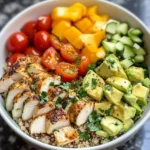
Gestational Diabetes Quinoa Bowl: 7 Essential Benefits for Moms
- Total Time: 40 minutes
- Yield: 4 servings 1x
- Diet: Diabetic
Description
This nourishing Gestational Diabetes Quinoa Bowl combines protein-rich quinoa with colorful vegetables and lean protein for a perfectly balanced meal that helps maintain healthy blood sugar levels during pregnancy. Each bite offers a delightful mix of flavors and textures while providing essential nutrients for both mom and baby. Ready in just 30 minutes, this customizable bowl is a satisfying solution for managing gestational diabetes without sacrificing taste!
Ingredients
- 1½ cups quinoa, rinsed and drained
- 3 cups low-sodium chicken or vegetable broth
- 1 tablespoon extra-virgin olive oil
- 1 small yellow onion, finely diced
- 2 cloves garlic, minced
- 1 medium zucchini, diced
- 1 cup cherry tomatoes, halved
- 1 red bell pepper, diced
- 1 cup baby spinach, roughly chopped
- 1 cup cooked, shredded rotisserie chicken (or baked salmon for a pescatarian twist)
- ½ cup crumbled feta cheese (optional, for a little tang)
- ¼ cup chopped fresh parsley
- Juice of 1 lemon
- Salt & freshly cracked black pepper, to taste
- A pinch of red pepper flakes (optional, for a family-approved little kick)
For the Creamy Avocado Drizzle (optional):
- 1 ripe avocado
- 2 tablespoons plain Greek yogurt
- 1 tablespoon fresh lime juice
- 2 tablespoons water (to thin)
- Salt & pepper, to taste
Instructions
- In a medium saucepan, bring broth to a gentle simmer. Stir in quinoa, cover, and reduce heat to low. Let it steam away for 15–18 minutes, until all the liquid’s absorbed and the grains fluff up. Remove from heat, fluff with a fork, and set aside.
- While your quinoa cooks, heat olive oil in a large skillet over medium heat. Toss in the onion and garlic—cook until fragrant and translucent, about 2–3 minutes.
- Add zucchini and bell pepper; sauté until tender-crisp, about 4–5 minutes more. Stir in cherry tomatoes and spinach, cooking just until the greens wilt.
- Fold the cooked quinoa and shredded chicken into the veggie mixture. Drizzle lemon juice over the top, and sprinkle with parsley, salt, pepper, and red pepper flakes. Give it all a gentle toss so every bite’s balanced.
- For the avocado drizzle (if you’re feeling fancy!): In a mini-food processor or with a fork in a bowl, mash avocado. Stir in Greek yogurt, lime juice, and enough water to reach a pourable consistency. Season to taste.
- Scoop generous portions into bowls. Crumble feta on top if using, then finish with a swirl of that creamy avocado drizzle.
Notes
- For diabetes-friendly meal prep, prepare components separately and assemble just before eating.
- This recipe works well with leftover baked chicken or salmon from previous meals.
- For a vegan version, substitute the chicken with 1 cup of cooked lentils or chickpeas and omit the feta cheese.
- Blood sugar response varies by individual—monitor your levels after eating to determine your personal response.
- The avocado drizzle can be made up to a day ahead if stored with plastic wrap directly touching the surface to prevent browning.
- Leftover assembled bowls will keep refrigerated for up to 3 days.
- Prep Time: 15 minutes
- Cook Time: 25 minutes
- Category: Main Dish
- Method: Stovetop
- Cuisine: Mediterranean-Inspired
Nutrition
- Serving Size: 1/4 of recipe (approximately 1.5 cups)
- Calories: 375
- Sugar: 5g
- Sodium: 320mg
- Fat: 16g
- Saturated Fat: 4g
- Unsaturated Fat: 11g
- Trans Fat: 0g
- Carbohydrates: 42g
- Fiber: 7g
- Protein: 22g
- Cholesterol: 45mg

